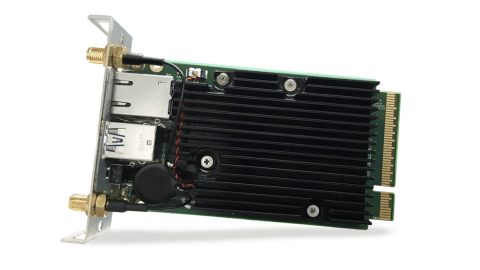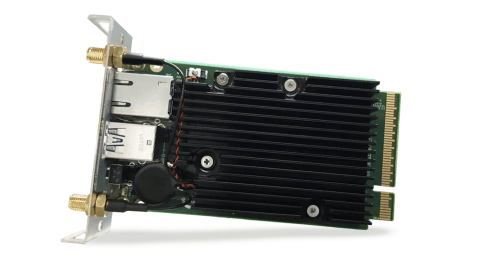
ISE 2017: Intel Announces Smart Display Module As Answer To Embedded Smart Signage Panels
February 9, 2017 by Dave Haynes
 Tech giant Intel has announced a plug-in module spec and reference design – called the Intel Smart Display Module or Intel SDM – that is intended, at least in part, as an answer and alternative for all those display manufacturers shipping all in one displays using ARM-based system on chip processors.
Tech giant Intel has announced a plug-in module spec and reference design – called the Intel Smart Display Module or Intel SDM – that is intended, at least in part, as an answer and alternative for all those display manufacturers shipping all in one displays using ARM-based system on chip processors.
The implications for the digital signage market, as explained to me yesterday at Integrated Systems Europe by Intel’s Jose Avalos, is that digital signage developers and operators now have an Intel-based option for displays, with different tiers of processors and therefore horsepower under the hood.
The way most “smart” displays work now requires software companies to develop or modify software for Android or a semi-proprietary OS like Tizen or WebOS. This module would allow Windows developers to have smart displays that stay in x86 andWindows. Same with Linux.
BroadSign, which was an early adopter of Android set-top box players but steered clear of SoC, is listed as an early user for this module, as is the Swedish CMS firm DISE.
Intel says the highlights of the device are:
- Roughly the size of a credit card in its initial design, Intel SDM allows for new all-in-one designs that benefit from the cost-effective implementation and management of integrated Intel processor-based media players;
- Its design omits housing, so it can be fully integrated into visual IoT applications like hospitality screens and bedside terminals that require minimal space with maximum performance;
- It incorporates high-speed PCIe* connectivity with a custom I/O receptacle board that eliminates the need for external I/O;
- Multiple offerings spanning Intel Atom to Intel Core processors support both basic and extended features with a connector that is future-proofed to support 8K resolution displays and video capture, when available.
The Intel announcement came with canned testimonials from initial partners (I say canned because no one naturally talks or writes like this):
“By o?ering scalable, future-proofed capabilities, the Intel® Smart Display Module (Intel® SDM) solves key challenges for digital signage network operators and integrators. The 7th generation Intel® Core™ processors o?er high performance, fanless reliability, and plenty of RAM and storage to deliver longer-lasting value than existing integrated solutions. With full support for Windows* and Linux*, our customers never have to be locked into a proprietary ecosystem with limited adoption.”
— Bryan Mongeau, Vice President of Technology, BroadSign
“The Intel® Smart Display Module (Intel® SDM) form factor specification allows Quanta to design tiny modules that easily slot into very slim displays. This provides scalable functions and features and enables the creation of digital signage with built-in intelligence that works right out of the box.”
— Terrisa Chung, BU1 VP and GM, Quanta Computer Inc.
Because this is a reference design, the smart display module is more than a bit like the Intel Open Pluggable Spec that Intel developed and released in 2010. That was a plug-in module and so is this, just smaller and different from the OPS and mini OPS products out there.
Both NEC and Viewsonic are listed as early adopters for these modules. NEC, for example, already has a design that accepts a Raspberry Pi micro PC as a board in a rear trap door.
“In 2010, NEC, Intel, and Microsoft formed a global strategic alliance and created the Open Pluggable Specification (OPS). Our focus was to deliver an optimized computing platform offering a more streamlined and high-performance standard for digital signage, interactive whiteboards, and mission-critical applications. Today, OPS is integral to NEC’s large-format displays and integration projectors. NEC sees the Intel® Smart Display Module (Intel® SDM) architecture as a natural evolution and is excited to expand our ability to deliver reliability, performance, standardization, and ease of use on a broader range of display form factors.”
— Richard Ventura, Vice President Business Development and Solutions, NEC Display Solutions of Americas
It is an interesting and not all that surprising move for Intel. It did the things it needed to do to mostly swat down the rise of low-cost external Android players, except in China (where they dominate the signage business). But just about ALL of the major display guys going big or all-in with system on chip displays is a problem when Intel sells chipsets for external players that are not needed when a network uses SoC panels.
The advantage here is that Windows and Linux guys – of which there are many – can stay in Windows and Linux, and not have to learn and support the Android variant of Linux or other displayco OSes. It also means they can snap in modules that meet the demands. So, a simple signage job may mean an Atom version of the module, while a network that has a lot going on at the display end – high-rez content and things like video analytics – can use a beefier core processor.
On the other hand, these snap-in devices will cost real, extra money – like external PCs – and the big pitch with smart displays is that the player is included in free (though they are not – the hardware costs are buried in the panel’s price).
There was a launch event for this last night in Amsterdam, but I (SNIFF!) wasn’t on the invite list. I did interview Avalos at length Wednesday and he talks about this in what will be an upcoming podcast episode.
This is a reference design and spec and not an Intel product like a NUC or Compute Stick. It means they are looking for hardware manufacturers – like Quanta and Viewsonic – to use that design to then develop and market their own products.



Leave a comment